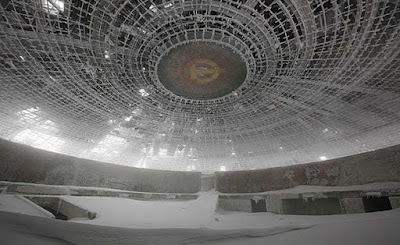Automatic doors through which a visitor's journey
begins.
Pins on the floor casually representing the Hong Kong identity.
Floor plan of Kwan's work on the left.
You arrive in the exhibition venue. Being drawn by the presence of this white
room, you find two doors operated by sensors. One door is facing the entrance carpeted locally
with plenty of pins with the shape of the Hong Kong
flag. The other door, tucked in on a
more obscure side of this triangular enclosure, provides an alternative point
of entry. If you have temperament like
me, you might choose this entrance instead of stepping on the pins to make a more
pronounced ingress.
The triangular room is a transition to the closed
space.
The closed space with a globe.
The globe shows an enlarged atlas of the Hong Kong territory only.
Upon entering through the automatic doors, the
triangle-shaped space automatically lit up by a fluorescent column within. Claustrophobic with unpleasant white light
that turns itself off as soon as movement is ceased, you are instinctively
prompted to find a way out. The only door,
again with automatic sensor, will lead you to the final room. There, full height
and filled with warm lights, a paper globe on a mirrored surface of a white stand
is found. You take a closer look and it
is revealed that the 'globe' only makes up of the geographical extent of the territory of Hong Kong
Who cares if there is no way out!
At one corner of this enclosure, the uncut paper
'globes' are ready to be taken home for re-assembly. Should you be ready to get out, you realize
that on this side of the room there is no sensor installed and you cannot leave
at will. You are stuck. Feeling puzzled or agitated perhaps, you look
for solutions; and at this point in time the artist equipped with closed
circuit cameras awaits your responses. Among
other options, one can yell for help, wait for others to come in then sneak
out, or waves hand towards the cameras (as I did).
Whirlwind tour of the enclosures.
Analogous to the current political stalemate of Hong Kong , the artist - Kwan Sheung Chi with his
installation tricks his viewers away from their comfort zones to confront themselves
with reactions in this closed space. In
this participatory work, the audience are encouraged to seek their own
solutions just as our city has to untangle itself from inner conflicts. Given the recent civil unrests, calls for constitutional
changes and even bickering on options of self-rule, there is an growing urgency
of people including Kwan to focus on the serious subject of Hong
Kong 's future.
Some cautious visitors with observation mode
switched on.
To quote from the curatorial statement on the
artist - Kwan devises accessible works
which he deems "necessary" by bringing perspective and clarity to the
context, underlined by a sardonic view of the vicissitudes of daily life. With the artist's unique visual language, the
curated works both old [the globe]
and new [the installation] sharply
address Hong Kong's culture, identity and future with deadpan irony, an issue
close to the hearts of many Hong Kong people.
A journey that leads nowhere as foretold by the
author.
In my two visits, anti-climax above all else was
what I could gather from the audience. Indifference to the closed space was the
mainstay while fun-seeking and selfies were other expressive responses; and
this was confirmed after chatting with the staff of the exhibition. High
order thinking was all but lacking. In
this installation-cum-experiment, only the artist and curators know best
regarding public's responses, given the recorded data they manage to gather
subsequently. If 'deadpan irony' of the
locals was Kwan's preoccupation, the installation manages to reveal the embarrassing
truth of the audience's participation - "a journey that leads
nowhere" (a statement he makes in the gallery's official website). Perhaps
this has been anticipated by Kwan, the revelation is his intent.
It is believed that this is one work among others
to come in the current political crossroad Hong Kong
is faced with. Personally speaking, due
to my leaving of this city for family reunion in Canada
Social Fabric
22 March to 21 April, 2016
Mill 6 Spring Exhibition, Hong Kong
















